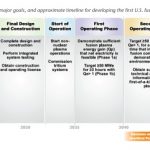Danone has pledged to cut its methane emissions by 30% by 2030 in its fresh milk supply. That makes it only one of three of the world’s top sixty livestock producers to have set a target. Methane has driven 28% of human-caused climate change, with almost a third of that from livestock. The key strategies are “improving herd and feed management, reducing manure-related emissions, and developing innovative methane inhibitor solutions.” The big … [Read more...]
Tandem solar cells (perovskite + silicon) can reach 40% energy conversion rates
Tandem solar lays new perovskite cells over standard silicon cells. Perovskite absorbs the shorter wavelengths of light that silicon misses. So the thin layer of perovskite collects the visible wavelengths, and lets the near-infrared light through to the silicon underneath. Martina Grünwald and Sarah Michaud writing for the WEF point at the results of R&D and demonstrations in Germany, Switzerland, Saudi Arabia and China. Energy conversion … [Read more...]
Simple superconducting diode can dramatically cut energy use in transistors, data centres
Some estimates say data centres could be consuming up to 20% of all power globally in ten years. That’s largely because the billions of transistors have to be cooled. Elizabeth Thomson at MIT describes breakthrough research that has made a superconducting diode that’s twice as efficient as the standard, therefore generating and wasting far less heat. What’s surprising is that some straightforward physics of materials was utilised, in contrast to … [Read more...]
“Flow Batteries” for grid-scale storage: modelling cheaper alternatives to Vanadium
Flow batteries are a promising new technology for grid storage. Rather than the standard batteries that store charge in a solid material, they use a solution to store that charge, making large-scale long-duration electricity storage much easier. Vanadium electrolytes have been the preferred choice so far, but affordable supplies are limited and a cheaper alternative will be needed for global scale-up, explains Nancy Stauffer at MIT who describes … [Read more...]
Geothermal’s full potential: 24/7 power everywhere, storage, environmental mineral extraction
Geothermal is not just for generating energy. It can be used for storage and extracting minerals too. Kelly MacGregor at NREL summarises the research into taking geothermal to the next level and making it a solution to multiple challenges. Depending on how far down you dig, geothermal is available for running utility-scale power plants as well as heating and cooling individual districts, buildings and houses. And new techniques are being … [Read more...]
Direct capture of CO2 from seawater: new research cuts costs, ready for pilot in 2025
Direct capture of CO2 from the air is already established in pilot phase in sites around the world, but costs are very high. So it is puzzling that capturing CO2 direct from the sea is yet to be tested properly. After all, the concentration of CO2 in seawater is more than 100 times greater than in the air, pointing at a process that should be much more efficient. David Chandler at MIT looks at research there that has uncovered cheaper and more … [Read more...]
From lab to commercialisation: what is the optimal pathway for Clean Energy Technologies?
It’s a considerable challenge to predict, decades in advance, what the world will need and get it from lab to market. Madeline Geocaris and Andrea Wuorenmaa at NREL summarise four case studies that reveal the key elements required: a good balance of technology, R&D, and public-private partnership; regulatory and market force alignment; good timing for market opportunities. The goal is the optimal pathway to the successful first … [Read more...]
Geopolitics and energy security require the U.S. and its allies to lead on Nuclear
Combine the current energy crisis with the geopolitical ambitions of Russia and China, and you have your reason for why the U.S. and its allies should prioritise nuclear, argues Robert Ichord at the Atlantic Council. All three nations have well-developed world-leading nuclear sectors. But it’s Russia that has been the largest exporter of nuclear reactors to the world market. Meanwhile, China has the most plants under construction at twenty. The … [Read more...]
Global Wind Speeds: are they falling due to climate change?
Last year, Europe experienced a “wind drought”, with wind speeds falling 15% in many regions, sometimes more. Deeper research shows speeds dropped gradually between 1978 and 2010, though rose again in the last decade. It’s difficult for the science to create a clear picture and predict long term trends. But the IPCC forecasts slowing winds for the coming decades, saying average annual wind speeds could drop by up to 10% by 2100. Jim Robbins at … [Read more...]
China: decades of support for innovation is now delivering results
The evolution of China’s clean energy sector used to be based on a technology catch-up approach, which meant secondary innovation based on imported technologies. Daisy Chi at ECECP looks at the IEA’s recent report, “Tracking Clean Energy Innovation: Focus on China”, to conclude that the nation is now a major force in clean energy innovation. Decades of innovation-focussed policies, strong funding support, institutional reforms, big targets and … [Read more...]
Aluminium, sulphur and salt batteries. Cheaper than lithium-ion, for homes and EV charging stations
The high and escalating demand for the lithium-ion batteries that dominate the market is driving the search for alternatives. Ideally, they will be made from inexpensive, abundant materials. David Chandler at MIT describes research there into a design that uses aluminium and sulphur as its two electrode materials, with a molten salt electrolyte in-between. The results point at batteries that have a projected cost per cell of about one-sixth that … [Read more...]
Getting Concentrated Solar Power (CSP) down to $0.05 per kWh
The U.S. Department of Energy is funding research to get the cost of Concentrated Solar Power (CSP) down to $0.05 per kWh. One key element of that research is the materials used to absorb and store the heat energy. Three categories of materials are being looked at: liquid (i.e. molten salt), particle (like sand), and gaseous. NREL is leading the molten salt research, and there are multiple challenges. The salts can corrode the storage tanks and … [Read more...]
Clean Hydrogen from water electrolysis: research into catalysts to meet global targets
The full potential of the new hydrogen economy will depend on producing enough clean hydrogen from water electrolysis which uses precious metals. But, as Glennda Chui at SLAC (Stanford University & DoE) explains, there aren’t enough precious metals in the world to get to the scale we need. And their cost is so high the clean hydrogen they generate could never compete with hydrogen derived from fossil fuels. Over 95% of hydrogen produced today … [Read more...]
Can the U.S. switch on a Nuclear Fusion plant by 2035?
Momentum is building in the U.S. for the switching on of a nuclear fusion pilot plant by 2035. A report from the National Academies of Sciences, Engineering and Medicine lays out for the first time the required technical, economic, and regulatory standards. It comes soon after the prospects for fusion were boosted in January by a government bill that funds fusion activities. Peter Dunn at MIT reviews the report and speaks to the experts. The main … [Read more...]
What effect will blending Hydrogen into the Natural Gas network have?
What are the technical barriers to blending hydrogen into the natural gas network? How well will the pipelines cope? How will the blend affect equipment and appliances? What are the costs and environmental impacts? The answers to these key questions are being sought by a collaboration of laboratories, industry and academia led by NREL, called HyBlend. The long-term impact of hydrogen on materials and equipment is still not understood. The effect … [Read more...]
















